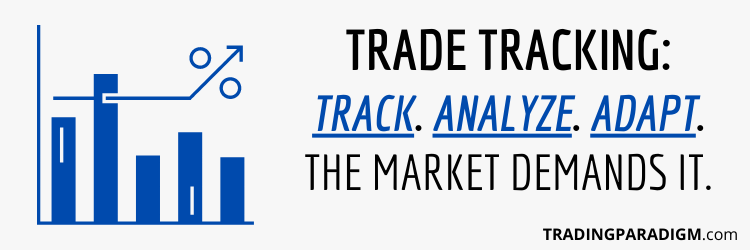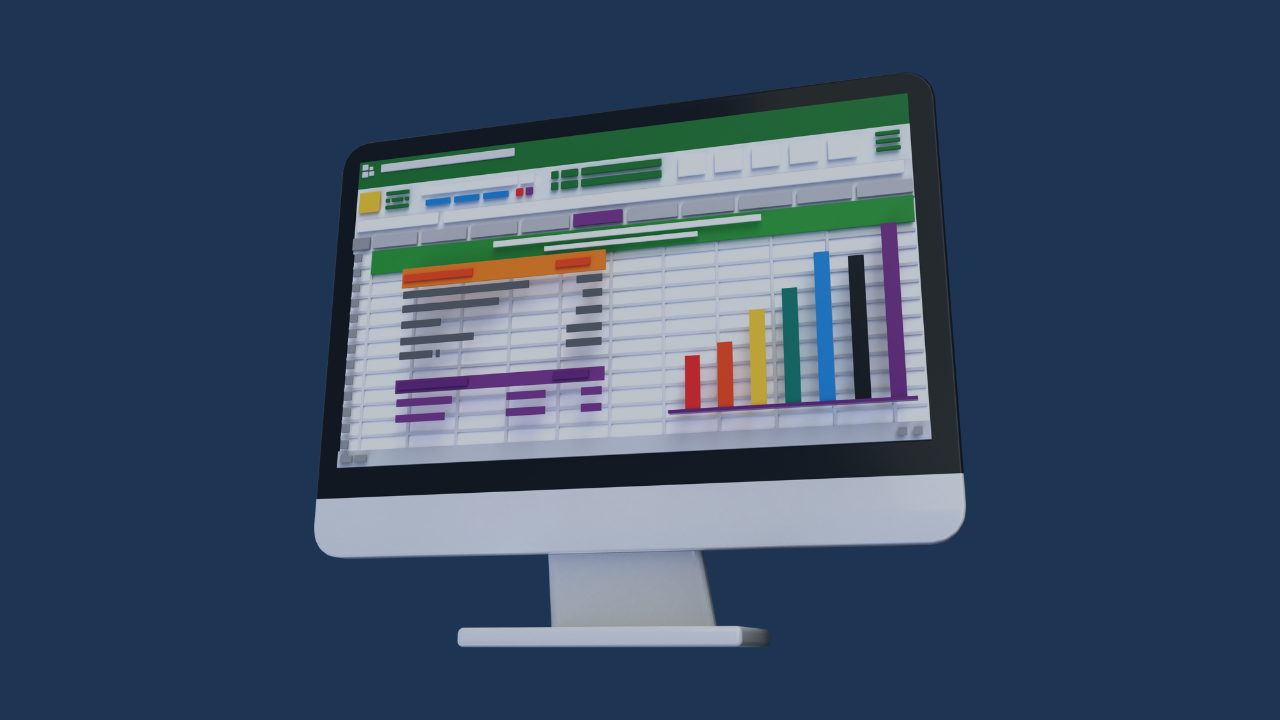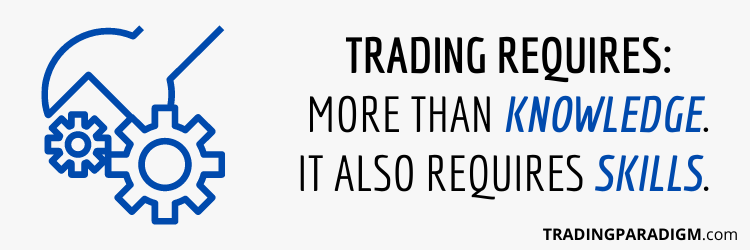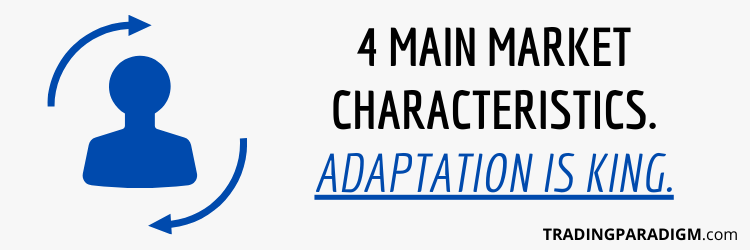What “Works” Can Vary Drastically From Trader to Trader and Market to Market:
When new traders are just getting started, they typically want to be handed a strategy/system that “works”. But what works for one trader might not work for another – and what works in one market might not work in another. It’s just not that simple.

It sounds nice when a trading guru claims they have a magical pattern that can make them (and you) millions of dollars like clockwork. But it’s nonsense. Basic patterns/setups like doji candles and double tops mean close to nothing on their own. You also need context.
As a prospective trader, understand that there are many factors at play. Each individual brings in their own personality, risk tolerance, account size, schedule, mental strengths, market experiences, trading skills, and more. There are no two traders exactly alike.
Then there are numerous markets: equities (with thousands of potential stocks to trade), forex (with hundreds of potential currency pairs to trade), futures (with dozens of potential contracts to trade), and more. No single strategy works the same in each environment.
Trading small cap stocks is different than trading large cap stocks. And trading S&P 500 futures is different than trading NASDAQ futures – which are both different than trading Crude Oil futures. Effectively trading each one requires experience and nuance.
So stop falling for the hype on foolproof/magical out-of-the-box systems – and start tracking your trades like a real trader.
Specific Trade Data/Information to Track For Every Single Trade:
It’s completely up to you to decide what you want to track and how to go about doing it (pen and paper, Excel spreadsheet, software built specifically for traders, or some mix of these), but there’s some basic information you absolutely want to be tracking:
- Market
- Instrument
- Setup
- Entry
- Exit
- Size
- Day
- Time
- Stop
- Profit Target
- Risk-Reward Ratio
- Catalyst
- Key Levels
- Indicators
- Sector Conditions
- Market Conditions
All of this might seem like a lot – and it is – but understanding and analyzing this context is what allows you to refine your process and improve performance. You have to look beyond basic candlestick patterns and setups for confluence.
For example, taking trades on every double-bottom that forms in every market, instrument, and time frame available probably wouldn’t be all that effective (or even possible). Without the right context behind it, the pattern itself isn’t all that strong.
But if you only take the ones on daily charts in equities with favorable sector/market conditions and a strong, stock-specific catalyst – the odds of the pattern working increase. Without the right context, however, it’s probably best to pass on the trade.
This, by the way, is not a comprehensive list of trade data/information to track – but it’s a good starting point. Ultimately, you have to figure out for yourself what should be tracked based on your own specific trading style and overall approach.
Paper notebooks and electronic spreadsheets can help, but I highly recommend TraderSync and Tradervue for even deeper insights.
Annotate Charts, Label Setups, and Archive Them For Future Study and Use:
A lot of people aren’t really interested in doing all this tracking and reviewing, but this is the work required to become elite.
I think Mike Bellafiore does a great job explaining how to properly track and review trades (with specific examples) in his two books: One Good Trade and The Playbook. So I highly recommend checking those out for insight into the world of professional trading.
But the idea behind doing it is simple. You want to internalize your best setups so that when they show up in real-time at the hard right edge of your charts – you’re completely prepared and ready to execute (like an NFL quarterback executing a touchdown pass).
Believe it or not – these guys even watch film of their trades, over-and-over again, reviewing them to see how they could’ve gotten better entries and exits, where they could’ve responsibly put on more size, and anything else they could potentially improve upon.
They’re closely monitoring the markets and their own process – relentlessly competing to get better every single day. So if you don’t give the market the respect it deserves by properly tracking, analyzing, and refining your trades, then you’re at a major disadvantage.
Success is the result of acquired experiences and skills – properly tracking/reviewing trades allows you to build up both of these.
The Wrap-Up – You Need to Be Able to Adapt Because Markets Are Open, Infinite Systems:
I talk a lot about following rules/plans and being structured/systematic, but I don’t want this to be confused with a lack of adaptation. No matter how systematic you are, you still have to be open-minded and flexible with what markets are telling you.
Markets simply don’t have the same closed, finite structure as other games. In chess, a second opponent can’t dump his pieces on the board and start attacking yours. In basketball, there aren’t fifty hoops to potentially score on – there are only two (one per team).
But markets don’t operate in this highly structured and regulated way. You never really know who you’re up against or who might jump off the sidelines at any given moment in time. The number of market participants to worry about is not fixed.
Market participants can come and go at their leisure with as much or as little capital as they want. Flows of money and market dynamics are in constant flux – and the game never ends. It can only be navigated with varying degrees of success over time.
Since there are no permanent truths that exist, you always have to be prepared to adapt. That’s what experience, skill, and being in-tune with the market does for you. Being entirely inflexible within a dynamic market is a recipe for disaster.
There will always be “something” to exploit from a probabilistic standpoint, but that something can change by the day/month/year.
Learn More in the Trading Success Framework Course
Written by Matt Thomas (@MattThomasTP)
Related Pages:
- Day Trading vs. Gambling – Is Day Trading Gambling?
- What is Asymmetric Risk-Reward in Trading and Investing?
- 3 Core Components of a Robust Market Methodology
- Trading is a Skill – Knowledge Will Only Get You So Far
- How to Get Started Trading With the Right Expectations






I completely agree that there is no one-size-fits-all strategy or system that works for every trader. As someone who is just starting out in trading, I have been looking for a magic formula that guarantees profits. However, after reading many articles on this site, I understand that trading requires a lot of hard work, discipline, and analysis. I found the list of trade data/information to track to be very helpful, but I wonder how I can develop my own specific trading style and approach. Do you have any tips on how to do this?
Hi Akumendoh,
Thanks for sharing your thoughts – and great question!
The development of your own style & approach will naturally develop over time based on your personal strengths, preferences, and experiences. So at first, it’s entirely OK to test out a handful of different approaches that you’re interested in (either in sim/demo or with a small amount of capital) just to see what resonates the most with you. From there, you can refine down and specialize a bit more. But it’s often hard to choose something that really suits your personality and preferences without an initial testing/discovery phase first. The mistake that a lot of new traders make is starting off extremely broad/general (and spreading themselves too thin) and staying in this kind of jack-of-all-trades phase forever – and as a result – never achieving any meaningful level of competence, skill, or consistency in any one single area. There’s way too many choices in terms of markets, instruments, strategies, timeframes, etc. to potentially pursue, so it’s simply impossible to be great at everything. The general discovery phase shouldn’t last forever, and after that phase, the best thing to do is refine down and specialize.
I also want to point out that I think it’s entirely fine to be unoriginal at first in order to develop a foundational level of market competence and trading skill. And as you grow and develop that competence and skill through experience (and start generating some solid results), you can earn the right to be more creative and original with how you approach markets. When I say this, however, I don’t mean you should subscribe to some chat room or alert/signal service and blindly copy the trades that some self-proclaimed guru is feeding you. I want to make this distinction very clear. I think it’s perfectly fine to “copy” somebody else’s process and test it out for yourself: like how they go about analyzing market context, and choosing strategies, and when to go about implementing those strategies, and how they choose stops and profit targets, etc. Doing this sort of thing actually teaches you how to view & analyze markets and adapt based on how the market is behaving – and that’s all very educational. But I absolutely don’t think it’s fine to blindly follow somebody else into a trade without any idea why, how to manage it, when to exit, etc. Blindly following alerts sounds great in theory, but it’s extremely dangerous and completely ineffective/unsustainable over time.
My own personal approach to markets is a mix of about 5-10 great traders (some of which have been more influential on my style than others), but I absolutely do not blindly make any buy and/or sell decisions based on what anybody else says or does. By being process-focused, I’ve built up the competence and skills to make my own trading decisions based on my own individual schedule, risk tolerance, cognitive strengths, etc. This is what every developing trader should be building toward in order to achieve long-lasting, sustainable success. It won’t happen by subscribing to a guru alert service. It happens by being trained and mentored in a powerful process, journaling & tracking trades, and having the market competence and technical, analytical, and mental skills to consistently make good decisions and appropriately adapt within ever-evolving markets. That’s what being/becoming a consistently profitable trader entails (contrary to what’s often displayed and “sold” within the trading education space).
To be honest, I have not had the nerve to trade on my own. I have a managed stock portfolio but have often wanted to “dabble.” Your article is interesting, but it also presents trading as exciting and complex. The number of factors to take into account is daunting. Is it possible, when trading on my own, to work with mutual funds as well as individual stocks? Also, I wonder what the minimal amount is to begin trading? I have signed up for the free course so I am anxious to start learning and give this try. Thanks for the opportunity. This is going to be a small start, but a start.
Hi Anastazja – I appreciate your questions!
Most people who get into trading never take the time to consider what being a trader truly entails – so that’s what the free Trading Success Framework course is all about. It covers the core values, characteristics, concepts, principles, habits, and skills required to become an effective trader. The masses think it’s all about stock-picking or following some guru’s trade alerts, but there’s a lot more to it than that. In this game, you really have to learn how to think from a probabilistic perspective and be able to make your own decisions based on data/feedback – that’s where trade logs and mindset journals come into play. It might seem overwhelming, but this is the work required to succeed. Most market participants overlook/avoid it, but that explains the low success rate (at least partially). The main quality amongst all successful traders I know is self-sufficiency. They might be part of a trading community or prop firm where they’re trading in a team environment, but they’re still self-sufficient. They’re not waiting on anybody else to tell them what to do. They’ve acquired the skills and experience to make their own decisions.
The minimal amount to begin trading is $0. One of the biggest mistakes new traders make is diving straight into the markets with thousands of dollars thinking they’re missing out on opportunities to make money (without any preparation or training whatsoever). But all they’re missing out on with this approach is emotional and financial pain. In my opinion, the ideal place to start is in a demo account that runs on live market data. This is a simulated (yet realistic) trading environment without any real capital at stake. The demo platform itself might cost a little bit of money depending on which one you choose (shouldn’t cost more than about $50 per month), but it’s much better than blindly throwing money around in the market without any real clue what you’re doing.
The real expense when it comes to trading – if you’re somebody who is genuinely interested in pursuing it at a serious level – should be proper training. Most prospective traders forego proper education and training because they claim it’s “too expensive”, but then proceed to lose tens/hundreds of thousands of dollars in the market essentially trading blind. That money, in most cases, would’ve been much better spent actually learning how to trade first instead of compulsively gambling it away in the market. Personally, I didn’t know any better when I first started trading either. I got sucked into all kinds of low-quality alert services and newsletters that I thought would help me, but all they did was promote a copy-cat mentality – which undercut my growth as a trader. It wasn’t until a few years later and cumulative losses of around $25,000 when I finally started to focus on the right things and stop the bleeding. If I was smarter, I would’ve taken half that time and half that money (which I had essentially wasted) and put it toward legitimate training that would actually help me develop into a real trader.
Hindsight is always 20/20. The best I can do now is try to point people in the right direction. But it’s not the direction most people want to go down (unfortunately). What most people want are the fancy cars, stacks of cash, and other ridiculous things they see in advertisements from fake gurus on social media platforms and other online channels. They don’t want the work (the training, trade tracking, journaling, review, etc.) – just the rewards. But that’s just not how it works. You can’t cheat the market long-term. It takes real work to achieve long-lasting, sustainable success.
To answer your question about potentially trading stocks and mutual funds on your own – you can trade whatever markets, instruments, and time frames you want to. But it’s important to realize the distinction between trading and investing. There’s certainly some overlap between the two (and it’s possible to do both), but I consider trading to be short-term holds (like intraday, maybe a few days, or a few weeks/months at most). Investing, on the other hand, is a completely different ballgame (hold times of a year or more). Putting money into a retirement account, like a 401K for example, that’s just going to sit in there for years/decades isn’t something I would consider trading – that’s investing. And to me, mutual funds and index funds fall into the investment vehicle category. But with that being said, it’s entirely up to you to decide what to trade – there are virtually endless markets, instruments, and time frames to choose from (equities, options, futures, forex, cypto, day trading, swing trading, position trading, etc.).
I hope this response helps and take care!
Boy, you are right, this all does seem like a lot! I like that you advise what amounts to a “test and learn” strategy to fine-tune what works for the unique market scenarios that individuals will find. Can you elaborate on what you mean by tracking catalysts? This seems like it could be a hard thing to pinpoint and definitely a hard thing to track. Thanks!
Hi Aly – great question!
A catalyst is essentially an underlying story, upcoming event, fresh news, or anything else that can cause a stock to move more than normal. Some typical examples of catalysts are earnings announcements, mergers/acquisitions, new product releases, economic events, and much more. For example, the legalization of marijuana in certain states can cause marijuana-related stocks to spike. Or if the fed decides to increase interest rates it can cause a sell-off in stocks. Or if a biotech company receives approval on one of their cancer drugs it can attract many new investors. Essentially, catalysts are reasons for traders/investors to reevaluate the fundamental strength/weakness of a company – and can attract hoards of new buyers/sellers (depending on the circumstances). It’s very important to label, track, and analyze the catalysts at play in specific trades to understand what’s bringing in volume and causing the product/instrument (stock, option, futures contract, etc.) to move. It might seem like a lot of work, but this is how you pin down what’s working (in order to do more of it) and what’s not working (in order to do less of it).
To give an extremely specific example, I knew a trader who experienced quite a bit of success mainly trading run-ups in biotech stocks. He would never hold through the events themselves, but he would find good technical entries roughly one to two months in advance of various drug approvals – and essentially cash in on the hype leading up to big announcements (exiting a couple days or weeks before the approval dates). The great part about this approach is that the biotech sector essentially has “built-in” catalysts. If you want to bring a drug to market, there are specific phases of approval that it has to go through – Phase 1/2/3, NDA, PDUFA, etc. And the approval dates aren’t a secret – they’re shared on company websites and various biotech databases that track this sort of thing. They’re not always exact, but they’re pretty good approximations. This structure (which isn’t necessarily the case in other sectors) makes it relatively easy to pinpoint catalysts. Over time – by labeling and tracking his trades – he realized that specific catalysts were much stronger (like phase 3 approvals as opposed to phase 1 and 2, and drugs that attempted to treat specific diseases as opposed to others). Without accurately labeling/tracking these catalysts, he wouldn’t have been able to refine his approach to a point where he could increase size with confidence on the setups offering better catalysts and decrease size (or not even trade) the setups with worse catalysts.